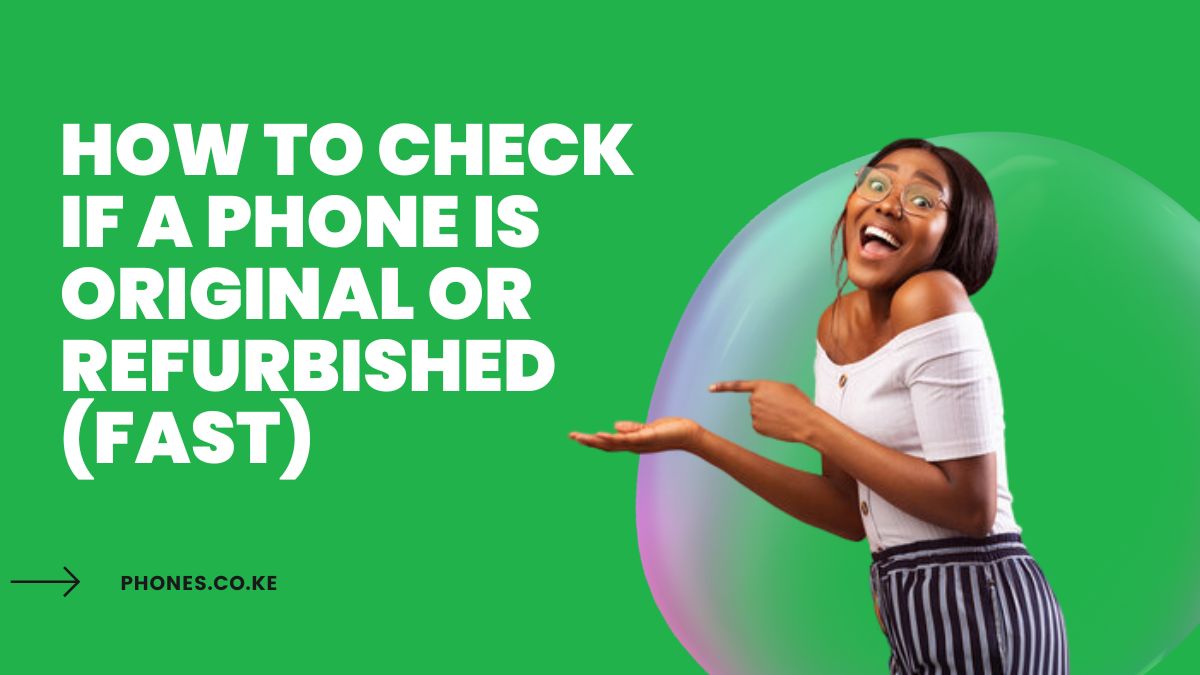How to Check if a Phone is Original or Refurbished (Fast) Leave a comment
Think you snagged a brand new phone at a steal?
Maybe. Or maybe you got played.
In the world of smartphones, “refurbished” can be a sneaky little devil. It might look new, feel new, even smell new (okay, maybe not smell new).
But under the hood? Could be a different story.
Why should you care?
Because a refurbished phone can be a ticking time bomb. You might face unexpected glitches, battery issues, or even a shorter lifespan. Plus, let’s be honest, nobody wants to pay top dollar for something second-hand, right?
So, how do you spot a refurb?
How to Check if a Phone is Original or Refurbished
Here’s the deal:
1. The IMEI Number
Every phone has a unique IMEI (International Mobile Equipment Identity) number. It’s like a fingerprint. And guess what? It can tell you if your phone’s had any “work done.”
Here’s the play:
- *Dial #06#: This magic code will reveal your phone’s IMEI number.
- Check the Settings: Go to “About Phone” or “General” (depending on your phone) and look for “IMEI.”
- Match it Up: Compare the IMEI from the code with the one in your settings. If they don’t match? Red flag!
- Go Deeper: You can even check the IMEI on the phone’s box or your purchase receipt. Still not matching? Houston, we have a problem.
Pro Tip: Use an IMEI checker website. These sites can give you even more info about your phone’s history, like whether it’s been reported stolen or lost.
2. Physical Inspection
Refurbished phones often have subtle signs of wear and tear. You gotta be a detective here.
Look for:
- Scratches and scuffs: Especially on the screen, corners, and charging port.
- Misaligned parts: Does the back cover fit perfectly? Are there any gaps?
- Battery wear: If the battery drains super fast, it could be a sign of a replaced (and possibly old) battery.
- Screen quality: Look for dead pixels, discoloration, or uneven backlighting.
Remember: A Grade A refurbished phone might look almost new. But a keen eye can still spot the clues.
3. Software Clues
The software can also reveal a phone’s true identity.
Here’s what to check:
- Operating System: Is it the latest version? Refurbished phones sometimes have older OS versions.
- Pre-installed apps: Are there any unusual apps or bloatware that you wouldn’t expect?
- Warranty: Does the phone come with a full manufacturer’s warranty? Refurbished phones often have shorter warranties.
Pro Tip: Use a third-party app like “Phone INFO+” for a detailed analysis of your phone’s hardware and software.
4. The Price is Too Good to be True? It Probably Is
Let’s be real, if that iPhone 14 Pro Max is selling for half the price, there’s probably a catch. Refurbished phones are usually cheaper. So, if the deal seems too good to be true, it probably is.
Don’t fall for:
- “Open box” deals: This could mean anything from a customer return to a refurbished unit.
- Vague descriptions: If the seller avoids using the word “new,” be suspicious.
- Unreliable sellers: Stick to reputable retailers and online marketplaces.
Remember: It’s better to be safe than sorry. Paying a little extra for a brand new phone can save you headaches down the road.
5. Ask the Seller Directly
Don’t be afraid to ask the seller point-blank if the phone is refurbished.
A reputable seller will be upfront about it. If they get defensive or evasive, that’s a red flag.
Here’s how to ask:
- “Is this phone brand new or refurbished?”
- “Can you confirm that this phone has never been repaired or replaced?”
- “What is the warranty on this phone?”
Pro Tip: Get the seller’s answers in writing (email or chat) so you have proof if there’s a dispute later.
6. Trust Your Gut: It’s Usually Right
Sometimes, you just get a feeling that something’s not right. If you have any doubts about a phone, don’t buy it. There are plenty of other fish in the sea.
Listen to your intuition:
- If the seller seems shady, walk away.
- If the phone feels “off” in any way, trust your gut.
- If the deal seems too good to be true, it probably is.
Remember: You’re the one spending your hard-earned money. Don’t settle for anything less than what you deserve.
Bottom line: Buying a new phone should be an exciting experience, not a stressful one. By following these tips, you can protect yourself from getting scammed and ensure you get the genuine article.
Read also:



